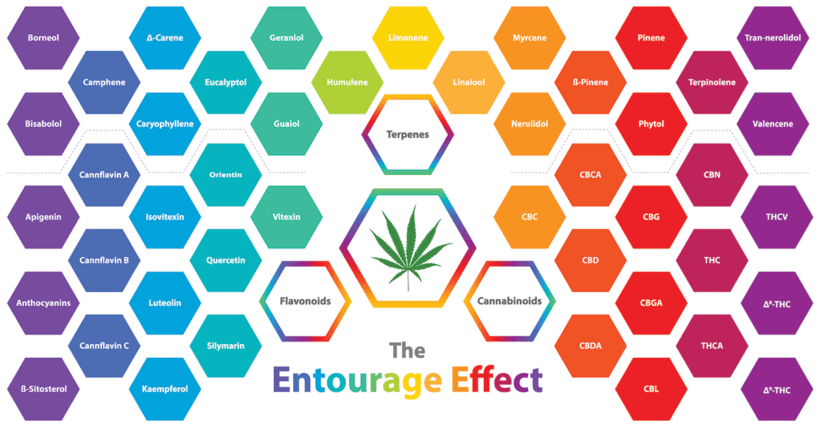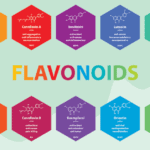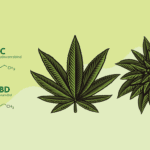Key takeaways:
- The entourage effect is the synergy between the cannabinoids, terpenes, flavonoids, and other compounds found in cannabis. It makes the effects of whole-plant cannabis preparations like full-spectrum CBD stronger than pure cannabinoids alone.
- Dozens of studies have shown evidence supporting the entourage effect. However, it’s still considered a theory, and further high-quality research is needed.
- To benefit from the entourage effect, opt for whole-plant cannabis products like full-spectrum CBD oil rather than pure CBD or THC.
The entourage effect is the scientific theory that whole cannabis plant extracts are more effective than isolated cannabinoids (1).
This “entourage” includes hundreds of cannabinoids, terpenes, flavonoids, and other components of cannabis that have beneficial effects and work together in synergy.
That’s why whole-plant cannabis products like full-spectrum CBD oil are considered more potent and effective than isolated CBD or THC.
Here’s a simple explanation of the entourage effect, the research evidence, and how to harness its potential.
Table of Contents
Components of the Entourage Effect
There are four main players in the cannabis entourage effect:
- Cannabinoids: the main active compounds in cannabis that interact with our body’s cannabinoid receptors. CBD and THC are the main stars, but there’s a “supporting cast” of over 120 minor cannabinoids like CBN, CBG, CBC, CBDa, and THCV (2). Cannabinoids are also believed to work in synergy with each other, with CBD and THC being the best examples.
- Terpenes: aromatic compounds that give plants distinct aromas, flavors, and health benefits. Cannabis contains over 400 terpenes, such as linalool, limonene, and pinene, which have many beneficial properties and may also enhance the effects of cannabinoids (3).
- Flavonoids: another group of compounds abundant in plants. Like terpenes, early research has shown that flavonoids may have beneficial health effects. Cannabis contains flavonoids such as apigenin, luteolin, kaempferol, and quercetin (4). Research on the interplay between flavonoids, cannabinoids, and terpenes is still in its early stages.
- Other compounds: cannabis also contains fatty acids, minerals, and other natural compounds (e.g. phenols, alkaloids) that may have synergistic interactions with the above components of the plant, but research is lacking (5).
One easy way to envision the entourage effect is to think of an orchestra. When working together, all of its components — brass, percussion, strings, and woodwinds — produce a sound that is more pleasant and harmonious than the individual instruments.
Similarly, the interplay of all the cannabinoids, terpenes, and other compounds in cannabis produces effects that are greater than the sum of their parts.

Discovery of the Entourage Effect
The entourage effect was first proposed in a 1998 Israeli study where legendary cannabis researcher Raphael Mechoulam and his peers examined the effects of 2-AG — one of the main endocannabinoids produced by the human body (6).
They discovered that when 2-AG was given to mice alongside two related cannabinoid compounds, effects such as pain reduction were more powerful.
This led the researchers to conclude that the activity of cannabinoids and their interaction with cannabinoid receptors can be enhanced by related compounds, leading them to coin this phenomenon as the “entourage effect.”
Evidence for the Entourage Effect
Since being proposed in 1998, the entourage effect has been demonstrated by multiple studies. For example, a 2010 British study reported the combination of THC and CBD reduced pain in cancer patients more effectively than THC alone (7).
Furthermore, a 2018 review by Brazilian researchers discovered that full-spectrum CBD-rich cannabis extracts were over four times more potent than pure CBD in the treatment of epilepsy (8). The review found that patients who took CBD-rich extracts needed much smaller doses and experienced fewer side effects.
Many animal and petri dish studies have also found evidence for the entourage effect:
- A 2022 study in mice found that CBD works in synergy with the common cannabis terpene beta-caryophyllene, producing greater pain relief (9)
- A 2015 study showed that mice given whole-plant CBD extract experienced a stronger reduction of inflammation and pain than those given pure CBD isolate and that pure CBD stopped having greater effects past a certain dose (10)
- The cannabis terpene alpha-pinene can suppress the enzyme that breaks down the neurotransmitter acetylcholine, potentially counteracting the short-term memory impairment caused by THC (11)
- Terpenes may help THC and other cannabinoids cross the blood-brain barrier, enhancing their effects (12)
- A 2021 petri dish study on neurons reported that THC had greater pain-desensitizing effects when combined with CBD and CBG (13)
In addition to research, we have thousands of years of anecdotal evidence of the efficacy of whole-plant medical cannabis preparations (14).
Nonetheless, it’s important to stress that the entourage effect remains a theory until we have larger and stronger evidence from randomized controlled trials (RCTs) — the gold standard of medical research.
Entourage Effect: THC Plus CBD
The best example of the entourage effect is the interplay between THC and CBD. Studies show that when administered alone, THC causes psychoactive effects — the “high” experienced by marijuana users.
However, when THC is combined with CBD, the undesirable psychoactive effects, including anxiety and paranoia, are reduced. Meanwhile, the positive effects, such as pain and nausea relief, are enhanced (15, 16).
Similarly, studies of cannabis users have reported that cannabis high in CBD produces less anxiety than THC-dominant varieties (17).

Entourage Effect Benefits
The main potential benefit of the entourage effect is enhanced potency. Any beneficial effect that you’re seeking from cannabis, such as pain relief, may be stronger with a product that includes all of the plant’s key components.
At the same time, whole-plant cannabis products typically require lower doses and may produce fewer side effects than isolated CBD or THC (8).
How To Harness the Entourage Effect
To make the most of the entourage effect, you should aim to use cannabis and hemp in a form as close to natural as possible.
The best examples are dried cannabis flower, full-spectrum CBD products, and other whole-plant extracts. If you’re not a fan of smoking or getting high, then full-spectrum CBD oil will be your best bet.
Meanwhile, products containing pure CBD (or any one other single cannabinoid) are the least effective since they lack their supporting entourage.
Whole-Plant Herbs Work Best
Although more high-quality human studies are needed to confirm that the entourage effect is indeed real, there’s growing evidence that whole-plant cannabis preparations are superior to isolated CBD or THC.
Researchers are also beginning to explore the concept of synergy in other herbal remedies, with early studies showing promising results (18). After all, herbal compounds are naturally found in their whole-plant form, which is how we’ve used herbal medicine for millennia.
The bottom line is that all whole-plant medications may be superior to isolated compounds because they maximize the synergistic benefits of all their ingredients.
References
- Russo, Ethan B. “The case for the entourage effect and conventional breeding of clinical cannabis: no “strain,” no gain.” Frontiers in plant science (2019): 1969.
- Walsh, Kenneth B., Amanda E. McKinney, and Andrea E. Holmes. “Minor cannabinoids: biosynthesis, molecular pharmacology and potential therapeutic uses.” Frontiers in Pharmacology 12 (2021): 777804.
- Ferber, Sari G., et al. “The “entourage effect”: terpenes coupled with cannabinoids for the treatment of mood disorders and anxiety disorders.” Current neuropharmacology 18.2 (2020): 87-96.
- Bautista, Johanna L., Shu Yu, and Li Tian. “Flavonoids in Cannabis sativa: Biosynthesis, bioactivities, and biotechnology.” ACS omega 6.8 (2021): 5119-5123.
- Radwan, Mohamed M., et al. “Cannabinoids, phenolics, terpenes and alkaloids of cannabis.” Molecules 26.9 (2021): 2774.
- Ben-Shabat, Shimon, et al. “An entourage effect: inactive endogenous fatty acid glycerol esters enhance 2-arachidonoyl-glycerol cannabinoid activity.” European journal of pharmacology 353.1 (1998): 23-31.
- Johnson, Jeremy R., et al. “Multicenter, double-blind, randomized, placebo-controlled, parallel-group study of the efficacy, safety, and tolerability of THC: CBD extract and THC extract in patients with intractable cancer-related pain.” Journal of pain and symptom management 39.2 (2010): 167-179.
- Pamplona, Fabricio A., Lorenzo Rolim Da Silva, and Ana Carolina Coan. “Potential clinical benefits of CBD-rich cannabis extracts over purified CBD in treatment-resistant epilepsy: observational data meta-analysis.” Frontiers in neurology (2018): 759.
- Blanton, Henry, et al. “Cannabidiol and Beta-Caryophyllene in Combination: A Therapeutic Functional Interaction.” International Journal of Molecular Sciences 23.24 (2022): 15470.
- Gallily, Ruth, Zhannah Yekhtin, and Lumír Ondřej Hanuš. “Overcoming the bell-shaped dose-response of cannabidiol by using cannabis extract enriched in cannabidiol.” Pharmacology & Pharmacy 6.02 (2015): 75.
- Russo, Ethan B. “Taming THC: potential cannabis synergy and phytocannabinoid‐terpenoid entourage effects.” British journal of pharmacology 163.7 (2011): 1344-1364.
- Andre, Christelle M., Jean-Francois Hausman, and Gea Guerriero. “Cannabis sativa: the plant of the thousand and one molecules.” Frontiers in plant science 7 (2016): 19.
- Anand, Uma, et al. “Dose-related inhibition of capsaicin responses by cannabinoids CBG, CBD, THC and their combination in cultured sensory neurons.” Journal of Pain Research (2021): 3603-3614.
- Russo, Ethan B. “History of cannabis and its preparations in saga, science, and sobriquet.” Chemistry & biodiversity 4.8 (2007): 1614-1648.
- Russo, Ethan, and Geoffrey W. Guy. “A tale of two cannabinoids: the therapeutic rationale for combining tetrahydrocannabinol and cannabidiol.” Medical hypotheses 66.2 (2006): 234-246.
- Sainz-Cort, Alberto, et al. “Opposite roles for cannabidiol and δ-9-tetrahydrocannabinol in psychotomimetic effects of Cannabis extracts: a naturalistic controlled study.” Journal of Clinical Psychopharmacology 41.5 (2021): 561-570.
- Hutten, Nadia RPW, et al. “Cannabis containing equivalent concentrations of delta-9-tetrahydrocannabinol (THC) and cannabidiol (CBD) induces less state anxiety than THC-dominant cannabis.” Psychopharmacology 239.11 (2022): 3731-3741.
- Williamson, Elisabeth M. “Synergy and other interactions in phytomedicines.” Phytomedicine 8.5 (2001): 401-409.

Gleb is a freelance writer from Vancouver, Canada specializing in CBD and cannabis. He’s read thousands of studies on CBD and other supplements, helping him translate complex science into plain language. Gleb has tried and reviewed dozens of CBD brands and products, written third-party testing reports, and knows the CBD industry inside and out. When not writing, he likes to kickbox, travel, and tell everyone how awesome intermittent fasting is.





